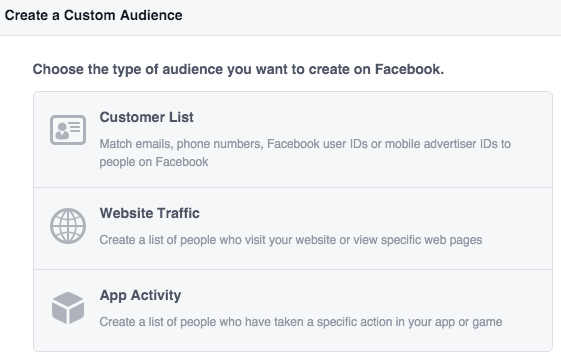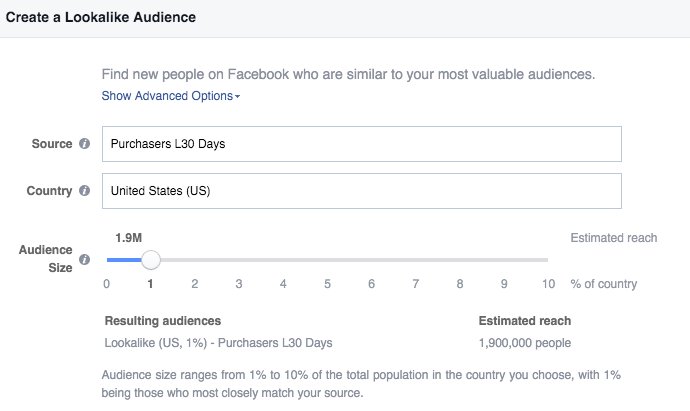If you’re looking to build awareness of your brand and attract new people, it’s hard to ignore the power of social media and the vast reach of Facebook. Millions of daily active users present a great opportunity to showcase your brand and discuss what you have to offer. With the ability to share, like, and comment, Facebook provides powerful options for users to become promoters of your brand.
This, in turn, can provide great bang for your buck brand building.
I know what you’re thinking. That’s great and all, but how do I actually use Facebook to reach new audiences?
That’s a great question.
To target new people, it always starts with building the proper audiences. Facebook isn’t AdWords – there are no keywords. What you can target are audiences based on a variety of options (interests, demographic information, behavior on your site, email lists, etc.). So understanding your potential customer and targeting them based on personas and behavior is crucial.
To be able to target new users, you need to set up two general types of audiences.
1. Those who are aware of your brand (purchasers, email subscribers, site visitors, etc.)
2. Those who are not aware of your brand.
That’s it. Seems pretty easy, but with anything in pay per click advertising, the complication can come in the details. Now let’s look at these audiences and provide some basic examples of how to build them.
Existing Purchasers And Site Visitors
Before you can even worry about targeting new users and growing your brand, you have to take the time to make sure you’re not targeting people who already know who you are. You can get started by building out two basic types of audiences.
• Converters (purchases or leads)
• Non-converting visitors
There are multiple ways to build these audiences using tools within Facebook. The most common method is to use your site specific webpages to segment out the behaviors you wish to track.
In the case of converters, you’ll want to track whichever webpage tells you that someone has performed a conversion. If you’re an ecommerce site this could be a purchase confirmation page or if you’re lead generation it could be a thank you page. Either way, you’ll want to fill your audience with people you know have converted.
The other audience to build is people who have visited your site, but haven’t converted. Here you’ll simply want to track anyone that has visited any page on your site. This audience will allow you to capture people who are familiar with your brand even if they haven’t converted.
There are a variety of other ways to create audiences of people you want to exclude from your growth campaigns besides using the webpages on your site. You could upload and use email lists of converters or you could base the audience on pixel activity. Email lists can be particularly useful if you have subscribers who show activity over long periods of time. Especially if you want to make sure you have the most recent list of converters to exclude.
The last consideration when creating these audiences is that of time frames. Do you want to exclude converters/visitors over the last 30 days or 60? Does 90 days make more sense or is there a special business case for even longer time durations? You’ll have to make that call based on your business, but it doesn’t hurt to create a few audiences at different time durations to have options.
Growth Audiences
Now that you’ve got your audiences with people familiar with your brand that we can safely exclude, it’s time to think through options on introducing your brand to new people.
Facebook allows you to target people in many different ways. You can target solely based on demographic information like gender and age or you could target people based on interests like cars or outdoor camping. You could also layer your targeting and include gender, age, and interests together.
One of the easiest audiences to set up for reaching new people is a lookalike audience.
Lookalike audiences are auto-generated audiences that attempt to mimic another type of audience. So you can create a lookalike audience based on people who have converted over the last 30 days and Facebook will attempt to fill the lookalike audience with people who demographically resemble those who have purchased.
It’s a great way to let Facebook generate a large pool of people who could be interested in your brand with relatively little input on your end. You simply choose the lookalike option, choose which audience you want Facebook to mimic, and then choose how similar the new lookalike audience will be.
Now when you create a campaign and set up your audience targeting, you can simply target the lookalike audience while excluding your converting and site visitor audiences (or email lists) to make sure the lookalike audience targets new people.
On the other hand, if you have a really good sense of the type of person you’re targeting and/or you just like to have more control, you can opt for more manual methods. In this scenario, you’ll pick the gender, age, education, income, geographic location, interests, and any other variables that match the persona you’re after. You’ll then use these to build out a custom audience of your choosing that you can save for future use.
You’ll then exclude your converters and site visitors to make sure this audience is targeting new users only. Now you have some audiences to target new users and build brand awareness.
Conclusion
As one of the largest social media platforms, the potential of Facebook can’t be ignored. Built for engagement, you’ll be hard pressed to find another platform with the scale to introduce your brand to new customers. By using the audience building techniques mentioned above, you’ll be ready to harness that scale and build your customer base.





